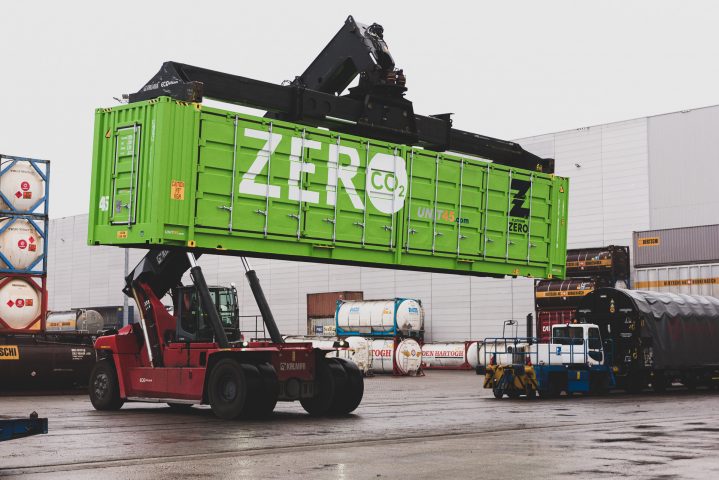The Case for Container Zero


Venture: how to fight the global emissions footprint of freight/shipping
Curtailing the emissions of ocean freight must be one of the most pressing environmental challenges in maritime. Yet, despite its sizable impact, the topic does not take centre stage in discussions about emission reduction. The root cause may be that so far it has proven to be hard, if not impossible, to transition the supply chain to net zero.
There are a number of reasons why ships are still going to emit CO2, and other harmful substances, in the years to come:
- Many ocean going ships are old, but still have a long life ahead of them. Although a typical lifetime of a ship typically is 20-30 years, there are many ships that reach 50 years of operation.
- Retrofitting a new sustainable engine is hard, if not impossible. A recent case, in which a cruise ship was literally sawn in half to remove the combustion engine is an indication of how hard (and costly) it is
- It is often unclear who should bear the costs for upgrading the ship (and taking it out of operation to install modifications), because ship owners are often not the operator of their own ships as there is usually a number of parties involved;
- Ultimately consumers thus far have wanted a low cost supply chain, and there has been a race to the bottom in price. Currently, sustainable shipping is more costly than using fossil-fuel powered alternatives. On the Asian-Europe route, ships are even known to sail around the Cape Good Hope (when oil prices are low) to avoid duties from the Suez channel, which adds a staggering 6,480km (Singapore to Rotterdam) to the trip.
- Legislation on shipping has been notoriously lacking. Particularly in Oceans that are not under jurisdiction of any government, it has been a wild west of emissions. It is now up to governments, governing bodies such as the IMO among shippers, to radically change this and create standards for emissions that can be actively enforced (and therefore adhered to)
Times are changing
So, the complexity of the industry, the costs of compensation, and the lack of zero-carbon propulsion systems, ultimately stop serious initiatives to cut carbon in shipping. However, the times are changing. Aside from the number of calories in our food, consumers are starting to take notice of the carbon in the manufacturing of their products. Case in point is oat-based milk alternatives that have grown widely popular over the past few years, such as Oatly, which claim a much smaller footprint than animal based milk products. However, the carbon footprint of the supply chain is often overlooked in the societal debate, and is likely to be the next ‘topic’ to address, as shipping a carton of oatmilk overseas is likely to incur higher carbon costs than sourcing local, regular milk.
There are more reasons why the times for a sustainable supply chain are changing:
- We are getting used to a higher price for shipping; with the current container shortage, costs for container shipping have never been higher.
- Traditional, carbon based fuel costs have never been higher
- Companies are taking sustainability seriously
- Shippers are seeing the light
- Consumers are increasingly conscious of their footprints
- More and more new technologies reach the market place: e.g. Co2 capture is taking off
- Ultimately: if consumers are aware of the additional cost of a net zero product instead of a polluting one, it is increasingly likely that they are willing to pay a significant premium for this.
Reshift the conversation
We believe that, in order to address the most pressing climate problem in the supply chain, we should reshift the conversation.
- Focus on the consumer: Decarbonizing the supply chain ultimately requires the end user (the consumer) to pay for it, and see its merit. Although shipping companies, ship builders, fuel providers and oil companies undeniably have a fair share of responsibility, they cannot solely be held responsible. We believe that any effort to structurally change the way the supply chain works, needs to put the end consumer (and its conscientious) in the middle.
- Work with pioneering brands to build momentum: consumers funnel their purchasing decisions towards leading brands. Sustainability is moving to the core of global commerce. Brands can differentiate themselves by embracing, endorsing and funding initiatives that restrict, reduce or compensate CO2.
- Use the container as our carrier: the container is, in more ways than one, a fantastic unit of measure, the workhorse of the supply chain, and a canvas for global branding. By creating visually stunning, green containers (that are green in their footprint also), we are creating an effective platform for brands to showcase their green credentials
- Compensate locally, both on the and off the ship: Many compensation schemes compensate in regions that are geographically distant from the place of emission. If we can ensure that brands compensate in regions where they pollute, we retain the connection between the location of emission and compensation
- Stimulate both compensation and innovation in compensation: we believe that we should compensate for emissions today and at the same time, ensure we are going to be better at carbon compensation in the future.
So what is container zero ultimately going to be?
Currently, container zero has taken form as a physical container, but there are still a couple of thresholds to take. Here is a short rundown:
- Government emission figures vary widely, and there is an incentive to present smaller numbers rather than large ones; of course, countries do not want to have an image as a polluter; determining a good emission figure per container is hard
- Compensation schemes are still a bit unclear; why do some programs offer a tree for under a dollar, whereas other companies charge tenfold. What if a field of trees burns down?
- We want to ensure that containers always are used for legal activities (i.e. no smuggling, narcotics, human trafficking or arms trade), this is hard to monitor/guarantee
- If for instance a fashion brands ‘purchases’ a container zero, we want to avoid that the container is used by its non-sustainable competitor; to ensure brands can reap the marketing value of their sustainable efforts
- Even though the Unit 45 container we have sourced is among the most sustainable container designs/ production footprints available (i.e. wooden flooring), we want to research even more sustainable options that have a beyond zero footrpint
- Ideally, the container stays in the area in which CO2 is compensated; this is currently impossible to control with container trade
What is the ambition level for container zero?
Currently we are aiming for the first 100 containers to set out on their itineraries in 2022. Every year we then want increase 10 times, until we reach a million by 2026; then we believe we have created the global awareness this problem needs, and we can focus on new challenges
How can you take part?
Do you want to be part of our Container Zero venture? Please send us a message via info@platformzero.co (whether you represent an established company, a talented startup or an aspiring professional)!
